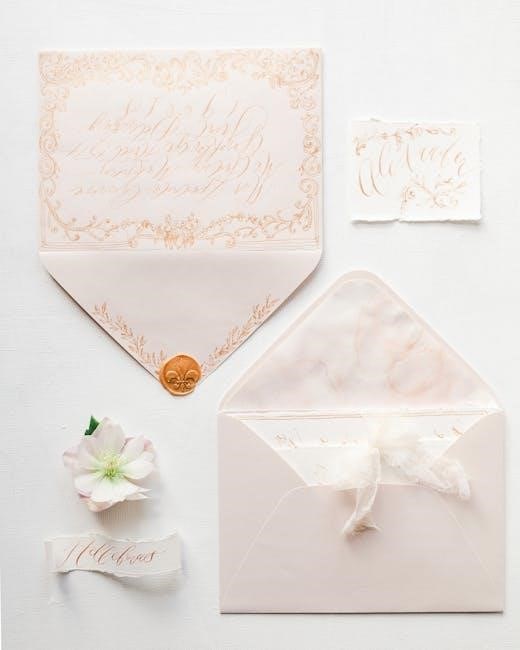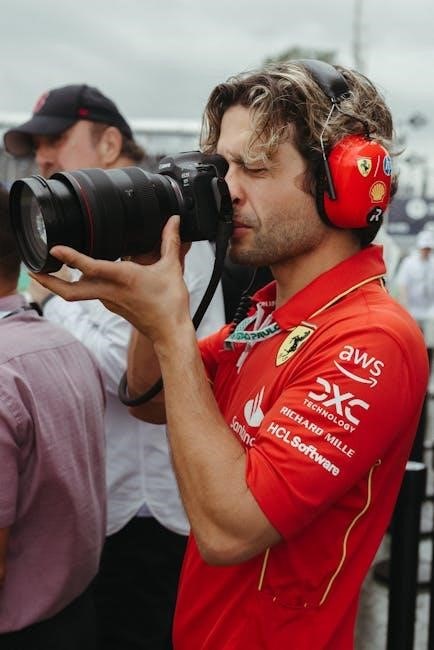A sponsorship request letter is a formal appeal to individuals or businesses to support an event financially or through resources. It outlines the event’s purpose and goals, aiming to establish a collaborative relationship for mutual benefit; This letter is essential for securing funding and resources, ensuring the event’s success while offering visibility and recognition to the sponsor.
1.1 Definition and Purpose of Sponsorship Letters
A sponsorship request letter is a formal document outlining a request for financial or in-kind support for an event, project, or initiative. Its primary purpose is to propose a partnership between the event organizer and the sponsor, offering mutual benefits such as brand visibility, community engagement, or networking opportunities. This letter serves as a professional proposal, detailing the event’s objectives, target audience, and how the sponsorship will be recognized, aiming to secure support while fostering a collaborative relationship.
1.2 Importance of Sponsorship Letters for Events
Sponsorship letters are crucial for securing financial or in-kind support, enabling events to cover costs like venues, marketing, and supplies. They foster relationships between organizers and sponsors, offering mutual benefits such as brand visibility and promotional opportunities. These letters outline expected benefits for sponsors, like logo placement or mentions, ensuring transparency and clear expectations. They enhance credibility, making events appear professional and attractive to potential sponsors. Additionally, they serve as a foundation for negotiations, detailing sponsorship levels and terms, ultimately contributing to the event’s success.
Understanding the Structure of a Sponsorship Request Letter
A sponsorship request letter typically includes an introduction, event details, sponsorship benefits, and a call to action, ensuring clarity and professionalism in presenting the request.
2.1 Key Components of a Sponsorship Letter
A sponsorship letter should include:
- An introduction of yourself or your organization.
- Details about the event, such as its purpose, date, and target audience.
- A clear statement of the sponsorship request and its scope.
- Brief information about the benefits the sponsor will receive.
- A polite call to action for the sponsor to respond or confirm their support.
These components ensure the letter is professional, concise, and effective in conveying the request.
Introduce yourself, your organization, and the purpose of the letter. Mention the event briefly, highlighting its significance and alignment with the sponsor’s values. Keep the introduction concise and engaging to capture the sponsor’s interest and set the tone for the request.
2.3 Body of the Letter: Event Details and Sponsorship Request
Clearly outline the event’s purpose, date, location, and target audience to provide context. Specify the sponsorship request, detailing how funds will be used (e.g., venue, marketing, or supplies). Highlight the benefits for the sponsor, such as brand visibility, audience reach, and alignment with the event’s mission. Be concise and persuasive, ensuring the request aligns with the sponsor’s interests and values. This section should compellingly justify why their support is crucial and beneficial.
2.4 Conclusion: Call to Action and Gratitude
Conclude the letter by expressing sincere gratitude for the sponsor’s consideration. Clearly state the next steps, such as contacting you for further discussion or confirming sponsorship details. Provide your contact information and emphasize willingness to answer questions. Reaffirm the mutual benefits of the partnership and the positive impact of their support. End on a positive note, leaving a lasting impression and encouraging a prompt response.

How to Write a Sponsorship Request Letter
Writing a sponsorship request letter involves understanding your audience, crafting a compelling narrative, and clearly highlighting the benefits for the sponsor. Ensure clarity and professionalism throughout.
3.1 Identifying the Target Audience
Identifying the target audience is crucial for crafting an effective sponsorship request letter. Research potential sponsors whose values align with your event’s mission and goals. Consider their industry, target market, and past sponsorship history to ensure relevance. Create a list of ideal sponsors and tailor your approach to each, highlighting how their involvement will benefit their brand and audience. Personalize the letter to show you’ve done your homework, demonstrating a clear understanding of their interests and how they align with your event’s objectives.
3.2 Crafting a Compelling Narrative
A compelling narrative in a sponsorship request letter captivates the reader by telling a story that aligns with the sponsor’s values. Start with a strong introduction that highlights the event’s purpose and goals. Clearly articulate how the sponsorship will create a win-win situation, emphasizing the event’s mission and the sponsor’s visibility. Use specific details about the target audience and how their brand will benefit. Keep the tone professional yet engaging, ensuring the letter reflects genuine understanding and enthusiasm for the potential partnership.
3.3 Highlighting the Benefits for Sponsors
Clearly outlining the benefits for sponsors is crucial in a sponsorship request letter. Emphasize how their contribution aligns with their brand values and target audience. Highlight opportunities for brand visibility, such as logo placement, social media mentions, and event program listings. Stress the reach and impact of the event, ensuring sponsors understand how their involvement enhances their reputation and customer engagement. Tailor the benefits to their specific interests, showing a clear return on investment and fostering a mutually rewarding partnership.
3.4 Including a Clear Call to Action
A clear call to action is essential in a sponsorship request letter. Specify exactly what you are asking for, whether it’s financial support, resources, or services. Provide details on how they can respond, such as contacting you directly or completing a sponsorship form. Include deadlines and any necessary information to make the process straightforward; This ensures the sponsor knows the next steps and can act promptly. A well-defined call to action increases the likelihood of a positive response and streamlines the sponsorship process.

Tips for Writing a Successful Sponsorship Letter
Personalize your letter, clearly state the event’s purpose, and highlight benefits for sponsors. Keep it concise, professional, and free of jargon to ensure a compelling request.
4.1 Personalization: Addressing the Sponsor by Name
Personalization is key to making your sponsorship request letter stand out. Always address the sponsor by their name to create a sense of familiarity and importance. This demonstrates that you’ve taken the time to research their interests and tailor your request specifically to them. A personalized letter shows respect and increases the likelihood of a positive response. Additionally, referencing the sponsor’s values or previous contributions can strengthen your appeal and highlight alignment with their goals.
4.2 Clarity and Conciseness: Avoiding Jargon
Clarity and conciseness are essential in sponsorship request letters to ensure your message is easily understood. Avoid using jargon or overly complex language, as this can confuse potential sponsors. Keep your request straightforward and to the point, focusing on the key details of your event and the benefits for the sponsor. This approach builds credibility and professionalism, making it more likely for sponsors to engage with your proposal. A clear and concise letter respects the sponsor’s time and demonstrates your seriousness.
4.3 Demonstrating the Value Proposition
Demonstrating a clear value proposition is crucial in sponsorship letters. Emphasize how the sponsorship aligns with the sponsor’s goals and brand values. Highlight the benefits they’ll receive, such as brand visibility, audience engagement, or networking opportunities. Tailor the proposal to showcase mutual benefits, ensuring the sponsor sees a meaningful return on their investment. Be specific about how their contribution will enhance their reputation and reach their target audience effectively.
4.4 Using Professional Language and Tone
Using professional language and tone is essential in sponsorship request letters to establish credibility and trust. Avoid slang or informal expressions, ensuring clarity and respect. Maintain a polite and courteous tone, expressing genuine appreciation for the sponsor’s consideration. Be concise and direct, while conveying enthusiasm for the event. Professional communication reflects the organization’s integrity and increases the likelihood of a positive response; It also demonstrates respect for the sponsor’s time and decision-making process.

Sponsorship Letter Templates and Examples
Sponsorship letter templates provide structured frameworks for drafting requests, ensuring clarity and professionalism. Examples offer inspiration and guidance for crafting effective sponsorship appeals tailored to specific events or causes.
5.1 Sample Sponsorship Request Letter for Events
A sample sponsorship request letter for events typically begins with an introduction of the event and its purpose. It outlines the sponsorship opportunities available, such as logo placement, event mentions, or exclusive branding rights. The letter should highlight the benefits for the sponsor, including visibility, brand exposure, and alignment with the event’s mission. It also includes a clear call to action, such as a deadline for response or a contact method. The tone is professional and persuasive, aiming to secure support while fostering a mutually beneficial partnership.
5.2 Templates for Different Types of Sponsorship Requests
Templates for sponsorship requests vary based on the event type, such as corporate events, non-profit fundraisers, or community activities. Each template is tailored to highlight the event’s unique aspects and the sponsor’s potential benefits. For example, a charity event template might emphasize emotional appeal, while a corporate event template focuses on brand visibility and networking opportunities. These templates provide a structured format, ensuring clarity and professionalism while saving time. They also allow for customization to align with the event’s mission and the sponsor’s interests, increasing the likelihood of a positive response.
5.3 Customizing Templates for Specific Events
Customizing sponsorship request templates ensures the letter aligns with the specific event and sponsor. Start by personalizing the greeting and addressing the sponsor by name. Tailor the content to reflect the event’s unique goals, target audience, and expected outcomes. Highlight how the sponsorship will benefit the sponsor, such as brand exposure, networking opportunities, or community engagement. Include specific details like sponsorship tiers, recognition opportunities, and deadlines. Ensure the tone and language match the event’s style and the sponsor’s values. This personalized approach increases the likelihood of a positive response.
- Personalize the greeting and sponsor’s name.
- Align the content with the event’s mission and goals.
- Highlight specific benefits for the sponsor.
- Incorporate sponsorship tiers and recognition details.
- Match the tone to the event and sponsor’s style.

Best Practices for Sending Sponsorship Letters
Send sponsorship letters well in advance, use professional language, and ensure clarity. Follow up politely after a week to express gratitude and confirm receipt. Use email or PDF formats for a polished look, and maintain a professional tone throughout the process to build trust and credibility with potential sponsors.
6.1 Timing: When to Send the Letter
The timing of sending a sponsorship request letter is crucial for its success. Ideally, letters should be sent 3-6 months before the event to allow sponsors sufficient time to consider and approve the request. Sending too early may lead to forgetfulness, while waiting too late can result in missed opportunities. Align the letter with the sponsor’s decision-making cycles and avoid sending during peak business periods. Follow up with a polite phone call or email within a week to confirm receipt and express gratitude, ensuring your request remains top of mind.
6.2 Following Up: How and When to Follow Up
Following up on a sponsorship request letter is essential to ensure it doesn’t go unnoticed. A polite phone call or email one week after sending the letter is recommended to confirm receipt and express appreciation for their consideration. Keep the tone professional and concise, reiterating the event’s value and alignment with their interests. Avoid sounding pushy but ensure they are reminded of the opportunity. If no response is received after two weeks, a second follow-up is appropriate to maintain engagement and address any questions they may have.
6.3 Using Digital Formats: PDF and Email
Using digital formats like PDF and email is highly effective for sending sponsorship request letters. PDFs ensure the letter’s formatting remains intact, presenting a professional image. Emails are convenient and allow for quick delivery, ensuring your request reaches the sponsor promptly. Always include a clear subject line and attach the PDF properly. Personalizing the email with a brief introduction can enhance its impact. This method is efficient, environmentally friendly, and aligns with modern communication preferences, making it easier for sponsors to review and respond to your request.
6.4 Ensuring Professionalism in Delivery
Professionalism in delivering sponsorship request letters is crucial for making a positive impression. Ensure the letter is well-formatted, free of errors, and uses a polite and respectful tone. Avoid slang or overly casual language, as it may undermine credibility. Use professional salutations and closings, and double-check for grammatical and spelling mistakes. The letter should reflect the organizer’s attention to detail and seriousness, enhancing the likelihood of a positive response. A well-crafted, professional letter demonstrates respect for the sponsor’s time and consideration.
Maximizing the Impact of Your Sponsorship Letter
Maximizing impact requires clarity, a compelling narrative, and highlighting the event’s mission. Emphasize the target audience’s reach and how sponsorship aligns with the sponsor’s brand, ensuring mutual benefit and visibility.
7.1 Highlighting the Event’s Mission and Goals
Clearly stating the event’s mission and goals is crucial for engaging potential sponsors. Explain how the event aligns with their values and target audience. Describe the purpose, objectives, and expected impact to demonstrate relevance and value. Highlighting the event’s significance helps sponsors understand how their contribution will make a meaningful difference, fostering a sense of partnership and shared success. Ensure the mission is concise, compelling, and directly tied to the benefits sponsors will receive, creating a strong foundation for their support.
7.2 Showcasing the Target Audience and Reach
Detailing the target audience and reach of your event is essential for attracting sponsors. Clearly outline the demographics, expected attendance, and engagement levels to demonstrate the event’s potential impact. Highlight how the audience aligns with the sponsor’s customer base or values. Include specifics about promotional efforts, such as social media campaigns or marketing materials, to show how sponsors will gain visibility. Emphasize the reach and exposure sponsors will receive, ensuring they understand the opportunity to connect with a relevant and engaged audience. This alignment strengthens their incentive to support your event.
7.3 Emphasizing the Sponsor’s Visibility and Branding
Highlighting the sponsor’s visibility and branding opportunities is crucial in a sponsorship request letter. Clearly outline how the sponsor’s logo, name, or products will be showcased during the event. Mention opportunities like logo placement on promotional materials, social media shoutouts, or event acknowledgments. Emphasize how this exposure aligns with their marketing goals and enhances their brand reputation. By detailing these benefits, you demonstrate the value of their investment and create a compelling case for their support. This mutual benefit strengthens their incentive to partner with your event.
7.4 Offering Different Sponsorship Tiers and Packages
Offering varied sponsorship tiers and packages allows potential sponsors to choose levels of involvement that align with their budgets and goals. Create tiers like Platinum, Gold, and Silver, each with distinct benefits such as logo placement, exclusive branding rights, or event participation. This approach ensures flexibility, making your event appealing to a broader range of sponsors. By tailoring packages to different needs, you provide sponsors with clear value propositions, enhancing their likelihood of contributing and fostering long-term partnerships. This strategy maximizes sponsorship potential while meeting diverse sponsor expectations.

Common Mistakes to Avoid in Sponsorship Letters
Avoid being vague about your request, ensure you research the sponsor’s interests, and clearly outline the benefits. Always proofread to maintain professionalism and clarity.
8.1 Being Too Vague About the Request
Being too vague about the request is a common mistake that can lead to confusion and disinterest from potential sponsors. Clearly specify the event’s purpose, target audience, and expected outcomes to help sponsors understand the opportunity. Avoid ambiguous language and ensure the sponsorship amount or type of support requested is explicitly stated. Providing specific details demonstrates professionalism and shows respect for the sponsor’s time and resources. A well-defined request also helps sponsors evaluate how their contribution aligns with their goals and values.
8.2 Not Researching the Sponsor’s Interests
Not researching the sponsor’s interests is a significant oversight that can reduce the likelihood of securing sponsorship. Sponsors are more likely to support events or initiatives that align with their values, goals, or target audience. Failing to tailor the request to the sponsor’s specific interests makes the letter appear generic and less compelling. Researching the sponsor’s past sponsorships, industry involvement, and corporate social responsibility initiatives ensures the request is relevant and demonstrates a genuine understanding of their priorities, increasing the chance of a positive response.
8.3 Overlooking the Sponsor’s Benefits
Overlooking the sponsor’s benefits is a critical mistake that can discourage potential supporters. Sponsors expect a clear return on investment, such as brand visibility, audience engagement, or networking opportunities. Failing to outline these benefits makes the request appear one-sided and unappealing. To avoid this, clearly articulate how the sponsorship aligns with the sponsor’s goals, such as increased brand exposure or access to a targeted demographic. Highlighting these benefits demonstrates the value of the partnership and encourages sponsors to invest in the event.
8.4 Failing to Proofread the Letter
Failing to proofread a sponsorship request letter can undermine its professionalism and credibility. Typos, grammatical errors, and unclear sentences may convey a lack of attention to detail, deterring potential sponsors. It is essential to review the letter for clarity, consistency, and proper formatting. A well-proofread letter demonstrates respect for the sponsor’s time and enhances the likelihood of a positive response. Always have multiple people review the letter before sending it to ensure error-free communication and a polished presentation.
Legal and Ethical Considerations
Ensure compliance with legal requirements, maintain transparency, and avoid misleading statements. Ethical practices, such as respecting privacy and avoiding conflicts of interest, are crucial for building trust with sponsors.
9.1 Ensuring Compliance with Legal Requirements
When drafting a sponsorship request letter, it is essential to ensure compliance with all applicable laws and regulations. This includes adhering to fundraising laws, tax requirements, and data protection standards. Clearly stating the purpose of the sponsorship and how funds will be used helps maintain transparency. Ensuring that all claims made in the letter are truthful and avoiding any misleading information is crucial to maintaining legal and ethical standards. Compliance not only protects the organization but also builds trust with sponsors.
9.2 Maintaining Transparency in the Request
Maintaining transparency in a sponsorship request letter is crucial for building trust with potential sponsors. Clearly outline the event’s purpose, goals, and how funds or resources will be utilized. Provide specific details about the sponsorship levels, benefits, and what sponsors can expect in return. Avoid vague statements and ensure all information is accurate and accessible. Transparency fosters credibility and demonstrates accountability, making sponsors more confident in their decision to support the event.
9.3 Avoiding Misleading Statements
Avoiding misleading statements in a sponsorship request letter is essential to maintain trust and credibility. Ensure all claims about the event, its reach, and benefits are accurate and evidence-based. Misleading information can damage relationships and harm future opportunities. Be truthful about the event’s scale, audience demographics, and how sponsorship funds will be used. Transparency and honesty are key to fostering long-term partnerships and ensuring sponsors feel confident in their investment.
9.4 Respecting the Sponsor’s Privacy
Respecting a sponsor’s privacy is crucial when drafting a sponsorship request letter. Ensure that any personal or company information shared by the sponsor is handled confidentially. Avoid disclosing sensitive details without consent, and safeguard their data from unauthorized access. Be transparent about how their information will be used and stored. Compliance with privacy laws and regulations, such as GDPR, is essential to build trust and maintain a professional relationship. Always prioritize confidentiality to protect the sponsor’s reputation and personal information.

Follow-Up and Follow-Through
Follow-up and follow-through are essential after sending a sponsorship request letter. Send thank-you notes, provide event updates, fulfill promises, and nurture long-term relationships with sponsors.
10;1 Sending a Thank-You Letter After Sponsorship
Sending a thank-you letter after securing sponsorship is crucial for fostering goodwill and maintaining strong relationships. The letter should express genuine gratitude, acknowledge the sponsor’s contribution, and highlight how their support impacted the event. Include specific details about the event’s success, such as attendance numbers or outcomes, to demonstrate the value of their sponsorship. This thoughtful gesture not only strengthens trust but also encourages continued support in future endeavors.
10.2 Providing Regular Updates on the Event
Providing regular updates on the event is essential to keep sponsors informed and engaged. Share progress reports, attendee numbers, and how their sponsorship is being utilized. Highlight any promotional activities featuring the sponsor, such as social media mentions or logo visibility. Transparent communication fosters trust and demonstrates appreciation, ensuring sponsors feel valued and connected to the event’s success. Regular updates also serve as a reminder of the mutual benefits of the partnership, encouraging future collaborations and ongoing support.
10.3 Delivering on Promised Benefits
Delivering on promised benefits is crucial to maintaining a positive relationship with sponsors. Ensure all agreed-upon obligations, such as brand visibility, logo placement, or exclusive access, are fulfilled. Provide sponsors with post-event reports detailing how their contributions were utilized and the impact of their support. Transparently showcasing the delivery of benefits strengthens trust and encourages future sponsorships. Fulfilling promises demonstrates professionalism and gratitude, fostering long-term partnerships and reinforcing the value of their investment in your event or organization.
10.4 Building Long-Term Relationships with Sponsors
Building long-term relationships with sponsors involves consistent communication and mutual benefit. Regular updates, personalized thank-you notes, and exclusive engagement opportunities foster trust and loyalty. Sponsors appreciate being treated as partners rather than one-time donors. By maintaining open dialogue and offering tailored opportunities, you create a foundation for recurring support. Consistent delivery on promises and shared success stories strengthen these bonds, ensuring sponsors remain invested in your mission and events, leading to sustained partnerships and mutual growth over time.